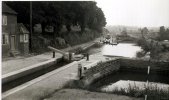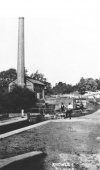Re the above cottages, Enock Mason, shown in photo below, was the lock keeper on stretch of lock 10 -13, by College Road Bridge. He also worked the pumping station in Deakin Avenue, Witton. The next door neighbour, who also worked for BW, as a builder, was Mr. Mrs Lindop.
The right hand side of the building was used for shoeing the cart horses. To the side was a very large stable which held overnight cart horses from the boats.
Just up from these cottages on the canal bridge, was the boat entrance to the coal wharf. Which can still be seen, although it’s built across.
These cottages were sold off in 1966, to build the small industrial estate, which is still there.
My grandfather and his wife, plus the next door neighbours, were moved to two new Dormer bungalows, built by BW at the side of the canal on the Walsall Road, lock 13. By this time both were retired age 72, but they had these properties rent free until their deaths. These properties were then sold about 1968, to Private buyers.
There ends the life story of Enock Mason, who gave 50 years of his life to working on the canal, plus polishing all the brass works in the pumping station in Deakin Avenue
 and keeping it in running order. He loved it.
and keeping it in running order. He loved it.Such fond memories of this cottage, where I lived as well , when I was small.
Every night to get to sleep, I walk the cottage remembering the rooms, the very large garden, and the outhouses, where gran used her ‘dolly maid’ to bash the washing, then put it through the ringer.
THE END, but not forgotten.
Attachments
Last edited:


















